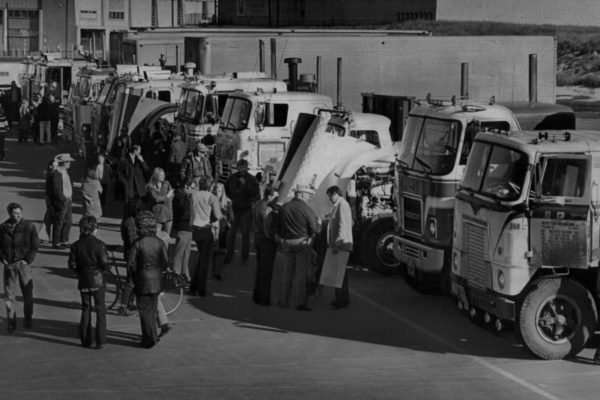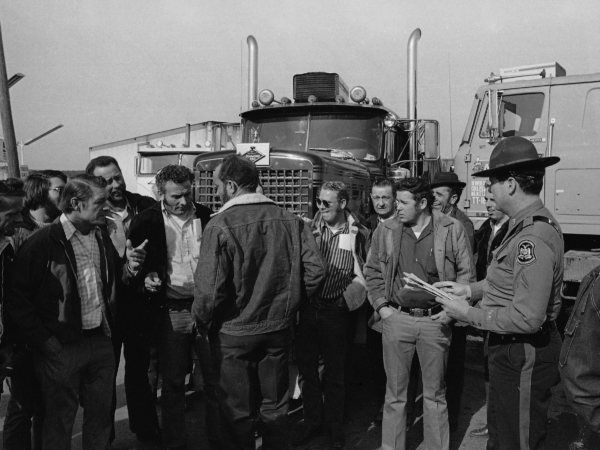As news surrounding a potential upcoming trucker strike gains traction, many are wondering what impact, if any, the demonstrations will have on the trucking industry, and even the country at large.
The initial strike – supported by groups such as StopTheTires2020, Trucker Strike 2020, and truck drivers across other various sectors of the internet – was planned for November 11th as a way to protest the potential fracking ban, the lack of consideration for truckers in coronavirus restrictions, and even the results of the 2020 election, which Trump has not conceded. While little seemed to happen on November 11th, the proposed trucker strike has the potential to get more serious by the end of the month, when four day protest activity is expected to begin.
Although it is not clear how many truck drivers are seriously planning to participate, a trucker strike spanning from November 26th through the 29th could really shake things up and get public attention — especially since it is so close to the holidays.
Truckers going on strike ! “November 29th , we park and don’t move . It’s the day we take this country back . It’s our time . We say what happens.” pic.twitter.com/XCg7oJfkm9
— VeBee🇺🇸✝️ (@VeBo1991) November 9, 2020
Despite garnering extra attention in the past year or so, the concept of trucker strikes isn’t new – the trucking industry actually has quite an extensive history of strikes.
One of the most infamous occurred back in December of 1973, when oil prices were skyrocketing by as much as 300% thanks to an oil embargo instated by the Organization of Arab Petroleum Exporting Countries (OAPEC). This embargo led to fuel rations in the United States and truck drivers were only allowed 50 gallons of fuel at a time.
When truck driver J.W. Edwards, better known as “River Rat,” ran out of fuel near Blakeslee, Pennsylvania, he decided it was time to shut ‘er down. River Rat parked his truck across Interstate 80, blocking traffic, and took to his radio, voicing his frustrations. After broadcasting his blockade via CB radio, other truck drivers began to join in to aid in his protest against high oil prices, limited fuel supply, and even proposed speed limits.
By the following day, truckers in more than 10 states were hosting their own demonstrations, stopping or at least slowing down on highways across America and majorly disrupting travel.

The protests went on for three days until River Rat and a small group of truckers met with members of Congress, who promised to get more fuel allocated for truckers. This promise satisfied the group of truckers, and River Rat agreed to broadcast a “cool it” message via high-powered Coast Guard CB transmitter, bringing most of the protest to an end.
Not surprisingly, the promises made to the truck drivers were not kept.
As a result, truckers reignited the protests in January of 1974, this time with more force thanks to the formation of the Owner Operator Independent Drivers Association (OOIDA) and other small independent trucker groups. As acting president of OOIDA, River Rat worked with Jim Johnston and helped to coordinate a major strike on January 31st, 1974. Truck drivers parked their rigs and even attacked truck drivers who weren’t participating, throwing bricks and rocks at their moving rigs as they drove beneath overpasses.

By February 7th, an agreement to allow owner operators to temporarily add a 6% fuel surcharge to their freight fees, along with the guarantee that truck stops would be given additional fuel to keep up with trucker demand, was reached between truck drivers and the government. It took several days and threats from the government to send in troops to calm things down, but by February 11th, most truckers were back on the road. But damage had been done – two truck drivers had been killed, there was a nationwide shortage of fuel and other goods, and more than 100,000 factory workers were laid off, all as a result of the protest.
The 1979 oil crisis, brought about by the decrease in oil production in the wake of the Iranian Revolution, once again sparked a series of trucker protests – this one more violent than its predecessors.
Truck drivers who did not participate in the strikes were once again attacked with bricks, rocks, and even shot.
This protest brought American commerce to a screeching halt. Factory workers were laid-off when factories couldn’t get the supplies they needed, farmers had crops rotting in their fields with no one to transport them to market, and even the cross-country migration of the American people was halted, as moving trucks refused to operate for fear of violence against them. President Carter even called the protesting drivers ‘terrorists.’
In 1983, yet another violent trucker strike began, lasting 11 days. Seventy drivers were injured and one was fatally shot through the neck in North Carolina, all protesting an increase in taxes on diesel fuel, large vehicles, and certain tires. The violent acts committed during these protests were strongly denounced by President Reagan, who stated that it would be the “worst thing in the world” for the government to cave in to those “committing murder.”
On February 10, 1983, the strike was called off thanks to the promise of a congressional hearing on truck taxes and new road users’ fees.
”[We have] been able to accomplish, for the entire industry, more than we have ever been able to in the past,” Overdrive founder and trucking activist, Michael Parkhurst, said of the February 10th agreement in a New York Times news conference.
“The shutdown brought to the forefront the actual truckers that Congress didn’t know about, that the media didn’t care about, which then also supported and influenced the start of big trucking movies,” he later said.
For many years afterwards, the trucking industry remained fairly quiet, faithfully hauling goods to Americans across the nation.
That is, until fuel costs rose again in 2008 thanks to tensions in the Middle East and inflation in the US. During that time, a few hundred truck drivers shut down or participated in slow rolls, but the demonstration did little to facilitate change.
Trucking protests surfaced again in 2014, when a small uprising of truck drivers at Los Angeles and Long Beach ports walked off the job in protest of low pay as a result of misclassification. The truck drivers claimed to be improperly classified as independent contractors, leaving them with lower pay and fewer protections in the workplace than those classified as company employees.
When asked about the possibility of a more widespread trucking shutdown the same year, Parkhurst suggested that it wouldn’t gain enough traction.
“They don’t have the guts or the money or the ability to organize a shutdown or, ‘hello why haven’t they done it?’” he said.
In 2018, following the implementation of ELDs and a desire for changes to the HOS rules, a group of truckers banded together on Facebook to form ‘Black Smoke Matters,’ a group that would act as the impetus for a series of protests in 2018 and 2019.
Black Smoke Matters was involved in and partially responsible for the 10-4 demonstration at the National Mall in October 2018 and a highway shutdown outside of Washington D.C. The group went on to organize two slow rolls in February 2019, one in March, and even planned a nationwide shutdown in April 2019 – all with the same demands:
- Hours of Service reform
- Updated truck driver training and safety standards
- A change to ELD regulations so that they are only required for companies with more than 10 trucks or trucking companies that have a poor safety rating.
- Standardization of inspections and Federal Motor Carrier Safety Administration (FMCSA) regulation enforcement
- More involvement from truck drivers in the creation of new FMCSA trucking regulations.
Posted by Lori Franklin on Thursday, October 4, 2018
Despite the group’s efforts, turnout to the demonstrations never climbed higher than a few dozen trucks. Although a small group of truck drivers was successful in shutting down a highway in Houston as protest against unfair load prices, insurance fees, and broker regulation.
While not exactly a strike, truck drivers were also able to orchestrate a meeting with White House officials after a nearly 3 week long vigil on Constitution Avenue in D.C. in May 2020. This meeting allowed two truck driver representatives to speak directly with White House officials, granting them the opportunity to ask for federal help in their fight against cheap freight.
With these modern-day trucking protests in mind, we are left wondering which direction the upcoming four-day November protest will take – will it follow in the footsteps of its violent, albeit somewhat more impactful, predecessors; or will it be just another ignored attempt to get truckers the treatment and consideration they deserve?
